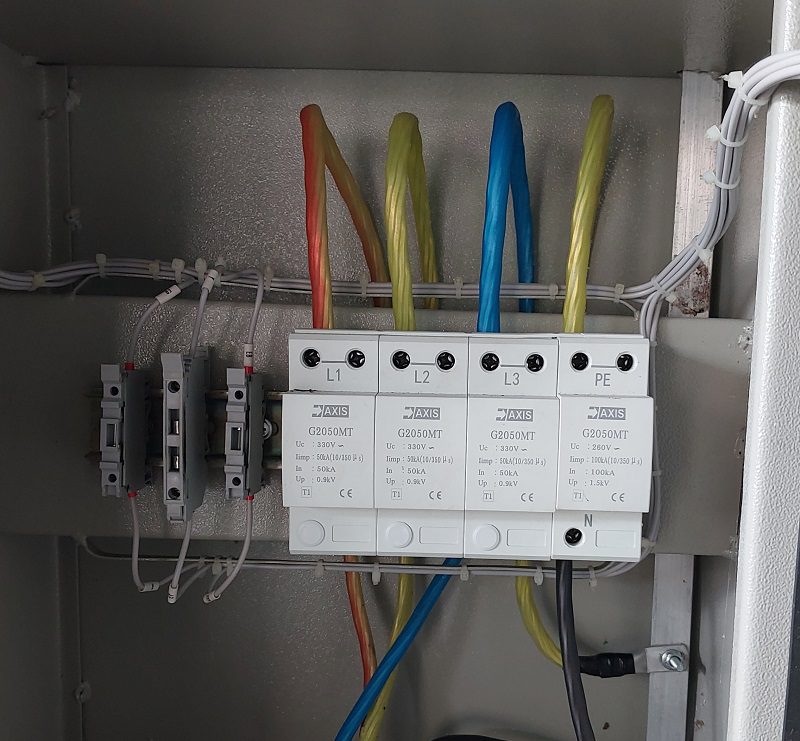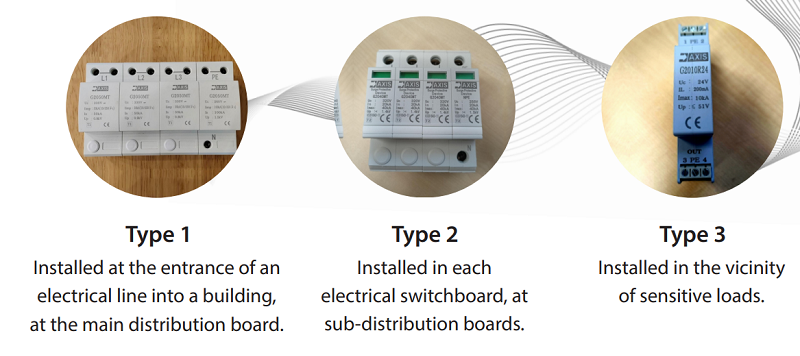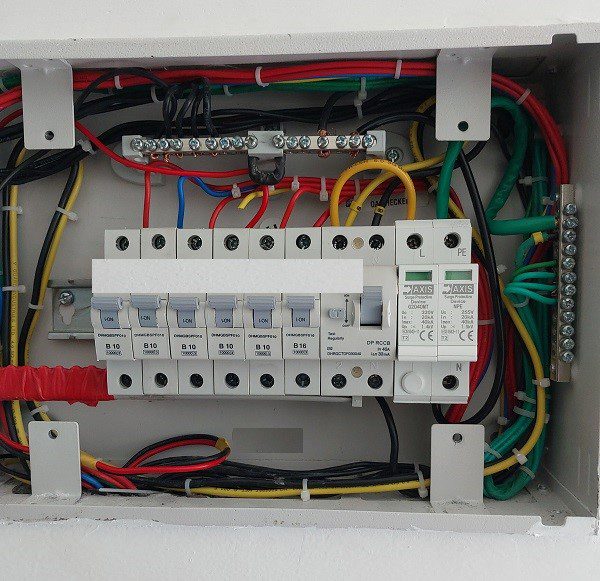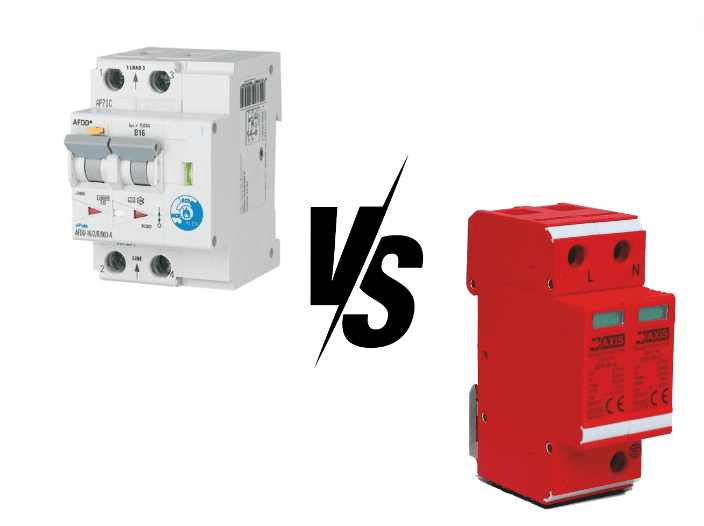In this blog we will understand Surge Protection Devices VS Circuit Breakers, by the end of this blog you will understand the difference between their applications, functions and types.
Surge Protective Devices (SPDs) are electrical devices, commonly installed in electrical power transmission and distribution systems, electrical power distribution panels, communications systems, process control systems, and other heavy-duty industrial systems. SPDs are installed to protect such systems and equipment against electrical surges and spikes, including those caused by lightning. Reduced or smaller versions of SPDs are occasionally installed in electrical service panels of residential units. For residential and household applications, SPDs are installed to protect their electrical installations, comprising the consumer unit, wiring and accessories, from electrical power surges also known as transient over-voltages. SPDs are also used to protect sensitive electronic equipment connected in an installation, such as computers, televisions, washing machines and safety circuits, such as fire detection systems, emergency lighting and other electronic items. Equipment with sensitive electronic circuitry is vulnerable to damage by transient over-voltages.
A surge can cause instant damage or failure to the equipment, therefore SPDs are installed in the electrical circuits of consumer units to protect the electrical installation. However, different types of SPDs are available to protect the installation from different types of surges. A transient overvoltage is a surge of electricity which occurs for a short duration due to the sudden release of energy, which is induced or previously stored by other means. Transient overvoltages can be either naturally occurring or man-made.

Naturally occurring transient over-voltages are caused by indirect lightning strikes, which usually happen when direct lightning strikes an overhead power line, telephone line or internet line in the near vicinity. This causes the transient overvoltage to travel along the lines, which can cause crucial damage to the electrical installation and its associated equipment. Man-made transients are caused by switching of motors, transformers and some types of lighting. This has not been an issue within domestic installations earlier, but more recently, installations are changing with the use of new technologies such as electric vehicle charging, new generation speed-controlled washing machines and air source/ ground source heat pumps. Such equipment are more likely to cause transients to occur within the domestic installations.
In an AC circuit a transient overvoltage, also known as a voltage spike, usually of 1 to 30 microseconds duration, can exceed voltages of 1,000 V. Lightning which strikes an overhead power line, can a voltage surge, in the power line, of the order of 100,000 V or more. When a running electrical motor is switched off, it can generate a voltage spike or surge of 1,000 V, or perhaps more.
Power transformer failures like lost neutral, or faults in distribution lines of other network power companies, can cause a long-term voltage surge, lasting for seconds, minutes, or hours, if not protected by SPDs. Voltage surges of relatively long durations can permanently damage the protection devices in an entire building, area or network. Even voltage surges having durations of tens of milliseconds can be longer than what a protection device can handle. There is a possibility that such long-lasting voltage surges may not be handled by protection devices like fuses and overvoltage relays.
How does Surge Protection Devices (SPDs) function?
When an SPD senses a transient overvoltage (also known as a voltage spike or a power surge) in a circuit, it operates by ‘diverting’ the current from the circuit to and through the connected surge protector, rather like a bypass route for current.
SPDs contain a Metal Oxide Varistor, commonly known as MOV. To draw an analogy, the MOV can be compared to a pressure relief valve, installed on a water main line. If the pressure relief valve was not present, excessive pressure could damage the water main line. Similarly, when the MOV senses a high voltage, its resistance reduces considerably, thereby routing the current through the SPD. This limits the voltage to a safer level in the circuit. After the transient is diverted, the SPD automatically resets to its initial high-resistance state. However, if the voltage is too low, the MOV’s resistance increases and prevents the current from flowing through the SPD. Thereby SPDs reduce transients to levels that will not damage or disrupt the operation of electrical or sensitive electronic equipment.
Types of SPDs

Broadly there are 4 types of SPDs as listed below:
Type 1 SPD
Also known as Class B SPDs, we recommend them in the LPZ 1 area. You should install them in the main panels of industries where the most lightning surges are expected. Type 1 SPDs can handle high energy levels. They are made with spark gap materials, that is two pieces of metal, insulated by a gap filled with gas or air. This material helps in managing intense surges
Type 2 SPD
Also known as Class C SPDs, we recommend them in LPZ 2 area. Their main function is to handle switching surges. These SPDs are made from MOV, a Metal Oxide Varistor. In simple words, it’s an electrical component whose resistance varies with the voltage.
Type 2 SPDs respond faster than Type 1, but they have a lower energy handling capacity. Therefore, we recommend installing Type 2 SPDs in distribution panels that follow the main panel, where the Type 1 SPD is installed.
Type 3 SPD
Also known as Class D SPDs, we recommend them in LPZ3 area. These SPDs have a low energy handling capacity and are installed at the end points of the electrical system, such as your socket, so that they respond quickly during a surge. Materials like diodes are used in the construction of these SPDs, enabling them to manage surges safely.
Type 1+2
Also known as Class B+C SPDs, are installed in panels where cables enter from outside a building. They have similar functions as Type 1 SPDs and are also installed in the same location. Made using a combination of Metal Oxide Varistors (MOVs) and Spark Gaps, they are more economical as compared to Type 1 SPDs.
Watch this video to understand the types in detail
SPDs according IEC61643-1

The IEC standard defines the SPD as – a device that is intended to limit transient overvoltages and divert. It contains at least one non-linear component.
1) Voltage switching type SPD
This type of SPD has high impedance under normal conditions. When a voltage surge occurs, the impedance immediately drops to a low value.
2) Voltage limiting type SPD
This type of SPD has high impedance under normal conditions. The impedance reduces continuously with increased surge current and voltage.
3) Combination type SPD
This type of SPD is a combination of voltage switching and voltage limiting type SPDs. It can exhibit the properties of voltage switching type, voltage limiting type, or a combination of both these types of SPDs, depending on the voltage surge characteristics.
Low Voltage Circuit Breakers
A circuit breaker is an electrical switch designed to protect an electrical circuit from damage caused by overcurrent/ overload or short circuit faults. Its basic function is to interrupt current flow and thereby prevent the risk of overheating and consequent fire in the circuit. Whereas a fuse, which operates once and then has to be replaced, a circuit breaker can be reset, either manually or automatically, to resume normal operation, and hence can be reused multiple times. Low-voltage circuit breakers are widely used in homes, residential buildings, hospitals, hotels, commercial complexes etc. They fall under the categories of MCCB (moulded case circuit breaker, MCB (miniature circuit breaker) and RCCB (residual current circuit breaker). An MCCB is a medium/ low-voltage, three-pole breaker whereas an MCB is a much smaller low-voltage, single-pole breaker. Both these circuit breakers protect against overcurrent/ overload and short circuits. A RCCB, on the other hand, protects against current imbalance due to ground fault.
How does a Low Voltage Circuit Breaker work?
The working principle of a circuit breaker is based on the interruption of the electric current in an electrical circuit. The circuit breaker mainly consists of fixed contacts and moving contacts. Simply put, the circuit breaker works like an automatic switch, which has a set current (base current) value. Whenever the current exceeds the set value, the circuit breaker switches off the circuit, wherein it is installed.
The circuit breaker operates in the following sequence:
1. Fault Detection – The circuit breaker detects the occurrence of a fault, which is either an overload or a short circuit, in the electrical system.
2. Activation of Mechanism – When a fault is detected, the circuit breaker activates its spring-loaded mechanism thereby triggering the release of stored potential energy in the spring.
3. Contact Separation – The stored energy thus released, separates the two contacts (or set of contacts for two-pole or three-pole) of the circuit breaker, namely the fixed contact and the moving contact.
4. Current Interruption – Separation of contacts interrupts the flow of current, thereby preventing any damage due to the fault condition.
5. Resetting – After the fault is cleared, the circuit breaker can be reset, which brings back together its fixed and moving contacts, thus allowing the current to flow again.
While dwelling on the functioning of circuit breakers, it is equally important to know the working principle of RCCBs (residual circuit breakers). The RCCB works on the principle of Kirchhoff’s Law, which states that, in an electrical circuit, the total incoming current must be equal to the total outgoing current. In a normal healthy circuit, the current flowing through the live and neutral conductors is equal and opposite in the direction of flow. In case of a fault in the circuit, such as damaged insulation or a person coming in contact with a live conductor, a part of the current gets diverted and flows to the ground. This results in an imbalance between the currents in the live and neutral conductors. The RCCB senses this current imbalance and triggers its tripping mechanism, thereby switching off the power to the circuit. The tripping time is instantaneous – in the order of milliseconds.
Surge Protection Devices vs Circuit Breakers

A surge protective device (SPD) protects electrical appliances from power surges (voltage spikes or voltage transients), whereas a circuit breaker protects wires from starting a fire due to overcurrent/ overload or short circuit.
• Circuit breakers protect wires against fire hazards.
• RCCBs protect you from electrical shocks due to inadvertent contact with live conductors
• Surge protective devices (SPDs) protect electronic items and electrical appliances from voltage spikes. They are highly recommended for protection against lightning strikes and system voltage transients.
A circuit breaker can help prevent damage to the electrical system in the event of an overload or short circuit, an RCCB protects human beings from electrical shocks, but they are not designed for protection against power surges. By installing surge protection devices at the main electrical panel and individual outlets or power strips, you can help safeguard valuable electronic equipment and electrical appliances from the damaging effects of power surges.
Thank you for reading the blog, Axis is a leading manufacturer and supplier of Electrical Components to over 80+ Countries. Talk to our industry expert by visiting our Contact Us section. You can also watch our videos by our experts – click here.






